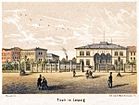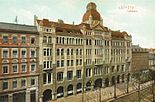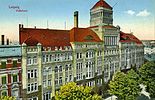Volkshaus (Leipzig)
The Volkshaus (trade union building) in Leipzig is an office and commercial building closely linked to the history of the trade union movement and is today the office of the ver.di trade union in the district of Leipzig and northern Saxony.
Location and shape
The Volkshaus is located on the main road to the south, Karl-Liebknecht-Straße , at number 30–32. This section of road is part of the district center-south in the district center.
The Volkshaus is a five-story building with a street front length of 67 meters. The middle part is apparently raised by two high floors, of which the upper one only represents a front panel for a roof platform behind it. There are two floors under the slightly bent gable roof. The top three floors of the house have two symmetrically positioned flat round bay windows . On the ground floor and on the first floor, two window axes are combined to form a round arch or a larger window. A 16-meter-long side wing adjoins the north side of the building.
Retail stores and a restaurant bearing the name of the building are located on the ground floor.
In the inner courtyard there is a monument to the poet Heinrich Heine .
history
From 1843 the “Tivoli” restaurant existed on what would later become the property of the Volkshaus. In 1891 about 40 workers' unions came together to build a union building. The Volkshaus GmbH founded for this purpose acquired the Tivoli property in 1904. The construction was carried out according to plans by the Leipzig architect Oscar Schade. The house had a symmetrical eleven- axis facade with a central and two side risers and a domed roof structure over the central sixth axis. The financing was provided from donations from the Leipzig workers as well as from membership fees from the trade unions and the social democratic party organizations. The house was inaugurated on June 15, 1906.
The house served as the seat for the unions and for holding their events. But it also had rooms, lounges, showers and bathtubs for the overnight stays of union members passing through. It also offered work-related organizations such as workers 'sports clubs, nature lovers or the Leipzig workers' training institute. During the First World War a hospital was set up in the gym .
During the Kapp Putsch , the Leipzig headquarters of the Spartacists was suspected to be here. That is why the Volkshaus was shot at by artillery and mine throwers on March 19, 1920 and then stormed by Reichswehr soldiers who looted the building and set fire to several places.
Under the slogan "In spite of everything", which was also carved into the street front, the reconstruction began with simultaneous expansion to the north. Every organized worker donated at least one day's earnings, and 200,000 “Volkshaus vouchers” worth 50 pfennigs were sold. The reopening could be celebrated on May 1, 1921.
In the new facade, three new axes with a flat round bay window were now inserted in addition to the middle section. This extension meant that for reasons of space, the northern side elevation could no longer be built, which led to a slight asymmetry. The middle part received a higher, tower-like structure.
In 1928 the building was again badly damaged by a major fire.
On May 2, 1933, the SA occupied the Volkshaus, which was later subordinated to the Nazi leisure organization Kraft durch Freude (KdF) and was renamed the “House of Work”. The despite-all-slogan has been removed.
In the Second World War , the house was destroyed again by bombing and after 1945 it was rebuilt in a simplified form and without the tower. In 1947, a simple Heinrich Heine monument donated by Leipzig trade union official Erich Schilling (1882–1962) was erected in the garden of the Volkshaus for his 150th birthday. In the GDR , the building was named Ernst-Thälmann -Haus and was the seat of the Free German Trade Union Federation (FDGB).
After the reunification, it became the property of the German Trade Union Federation (DGB) and became the seat of individual trade unions. In 2006 the DGB sold the Volkshaus Leipzig along with nine other union houses in the new federal states to Cerberus Capital Management . In 2009 the Volkshaus Leipzig was bought back by the ver.di union .
literature
- Horst Riedel: Stadtlexikon Leipzig from A to Z . PRO LEIPZIG, Leipzig 2005, ISBN 3-936508-03-8 , p. 624
- Heinz Peter Brogiato: Leipzig around 1900. Second volume: The city districts in colored postcards from the archive of the Leibniz Institute for Regional Geography Leipzig eV Lehmstedt, Leipzig 2009, ISBN 978-3937146-46-1 , p. 20
Web links
- Monika Kirst: “In spite of all that!” The Volkshaus Leipzig and its history . ( DGB website ), accessed on February 24, 2014
Individual evidence
- ^ Wolfgang Hocquél : Leipzig. Architecture from the Romanesque to the present. Passage-Verlag, Leipzig 2001, ISBN 3-932900-54-5 , p. 299.
- ↑ Ralf Julke: Kesselgulasch, Fettbemmen, Drummlergruppe: Trade unionists celebrate the buy-back of the Volkshaus today ( Memento from February 28, 2014 in the Internet Archive )
Coordinates: 51 ° 19 ′ 39 ″ N , 12 ° 22 ′ 24 ″ E







